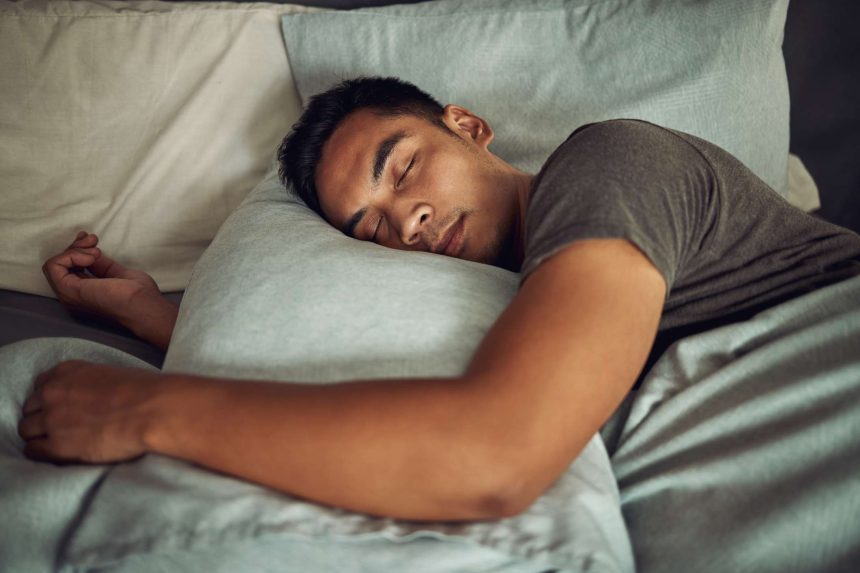Sleep is crucial for your overall physical and mental health, but many adults report having trouble getting quality sleep. Various sleep methods claim to help people attain the recommended 7 or more hours of sleep per night. One of these formulas, known as the 10-3-2-1-0 sleep rule, focuses on building daytime habits to support longer, better rest.
The 10-3-2-1-0 sleep rule is a sleep routine that has grown in popularity after circulating the internet, originating from a social media post from sports medicine physician and pediatrician Dr. Jess Andrade.
The sleep method outlines pre-sleep habits that you can implement in the daytime, 10, 3, 2, and 1 hours before bed. The goal is to help you prioritize the amount and quality of rest you need—before sleep deprivation adds up.
10 Hours Before Bed: No Caffeine
The first step in this method is to stop your caffeine intake a full 10 hours before bedtime. So, if you want to get to sleep by ten, your last cup should be before noon.
As a stimulant, caffeine increases energy levels and makes you feel more awake—which is the opposite desired effect when you’re aiming for a restful night’s sleep.
There is evidence to back up this rule. Caffeine can be beneficial in the morning and in moderation, but because its effects can last for up to six hours, experts often recommend avoiding it for several hours before bedtime.
To help limit caffeine consumption while still maximizing your daytime energy, consider the following:
- Get bright sunlight exposure first thing in the morning
- Exercise earlier in the day
- Swap out caffeinated drinks for more hydrating options like water, herbal tea, tart cherry juice, or a turmeric latte
3 Hours Before Bed: No Food or Alcohol
According to the 10-3-2-1-0 rule, your last meal should take place at least three hours before sleep time.
Research suggests that eating too close to bedtime makes you more likely to wake up frequently throughout the night. Plus, while drinking alcohol may make you feel sleepy initially, it disrupts your sleep cycle by reducing rapid eye movement (REM) sleep. Getting enough REM sleep is essential for supporting brain function.
Avoiding food before bed can also help you align with your circadian rhythm (the body’s internal sleep-wake clock). The circadian rhythm signals the body to prepare for digestion during the earlier part of the day rather than later. Sleep experts recommend avoiding heavy food and drink within a few hours of bedtime.
If you’re still craving a light snack or alcoholic beverage at night, consider the following strategies:
- Eat regularly throughout the day so you aren’t as hungry at night
- Choose a nutritious snack with protein and fiber to keep you feeling full without spiking your blood sugar
- Replace midnight snacking with another habit, like reading a book or sipping tea
- Swap nightly wine for a non-alcoholic option, such as a mocktail or soda water with lime.
2 Hours Before Bed: No Work
The next part of this routine involves signing off from any work duties two hours before your desired bedtime.
Activities that stimulate your mind can prompt alertness, making it more difficult to fall and stay asleep. This may be particularly problematic if you work from your phone in the evenings. Some research suggests that active nighttime phone use—like emailing or engaging with coworkers—may interrupt sleep more than passive nighttime screen activities, like watching TV.
This tactic is backed by expert guidance, which advises keeping your work out of the bedroom entirely, if possible. To detach from work, save mentally demanding tasks, such as emailing, for the next morning. Instead, use your pre-sleep hours to focus on a physical relaxation practice like yoga or light stretching to induce sleepiness and prevent burnout.
1 Hour Before Bed: No Screens
The last step before bedtime is shutting down screen time on all phones, TVs, and computers one hour prior to sleeping.
Exposure to artificial light at night can negatively affect your circadian rhythm. Shortly before sleep, your brain emits the hormone melatonin to signal to the body that it’s time to settle down for the night. Using a blue light-emitting device, like a smartphone, before bed can suppress the melatonin release—pushing back your natural sleepy time.
Experts agree with this screen-time tip, suggesting that the last hour before bed should be mostly quiet time without bright artificial light that would cue your body to wake up. To accomplish this, you might:
- Make your bedroom a completely screen-free zone
- Put your phone on nighttime mode
- Create an alternative relaxing bedtime ritual to prepare your mind and body for slumber, like cozying up with a blanket and book or turning on a soothing white noise machine.
Zero Times Hitting Snooze in the Morning
In the 10-3-2-1-0 routine, hitting the snooze button is completely off-limits. The thinking behind this rule is that “snoozing” disturbs your sleep cycle.
While disrupted sleep has been shown to have short- and long-term health consequences, opinions are mixed on whether hitting snooze is a substantial disruption.
Some research has found this practice might be beneficial—and not necessarily harmful—for some people. For instance, people who need the extra sleep may benefit from snoozing. However, researchers noted habitual snoozing may indicate a larger problem, such as a sleep disorder.
Choosing to press snooze may suggest that you’re dealing with sleep deprivation. If you go to bed late and need more sleep in the morning, consider setting your alarm a bit later to maximize your sleeping time. Or, if you want to stop your snoozing habit, try physically moving your alarm device across the room so you have to get out of bed to turn it off.
Creating a routine for winding down at bedtime can help set you up for sleep success. Here are some expert-backed sleep tips to try:
- Improve your sleep environment: Keep your bedroom cool, dark, and quiet, if possible
- Keep your sleep schedule consistent: Aim to go to bed and wake up at the same times every day, even on weekends
- Avoid napping: Only take a short nap before two p.m. if necessary, and avoid napping during the evening
- Stay active throughout the day: Try to walk or exercise for at least 30 minutes most days
- Incorporate calming evening activities: For example, take a warm shower and listen to relaxing music
- Get out of bed: Get out of bed if you toss and turn for more than 20 minutes, and engage in a calming activity like reading until you start to feel sleepy
If the mere thought of not being able to sleep causes anxiety, you’re not alone. Consider seeing a healthcare provider if you often have trouble sleeping, frequently feel tired during the daytime, or experience difficulty completing daily activities due to a lack of sleep.
The 10-3-2-1-0 sleep rule involves a series of daytime steps to promote a better night’s sleep. This routine aims to help you adopt healthier sleep habits by stopping caffeine consumption, limiting snacking, avoiding work stimulation, and halting screen time at certain times of the day. In the morning, you should avoid hitting the snooze button.
Keep in mind that this method may not be right for everyone. Check with a healthcare provider if you have questions about your personal sleep and health needs, especially if you have an underlying health condition.







